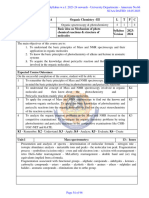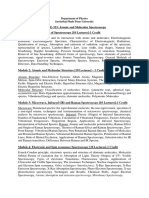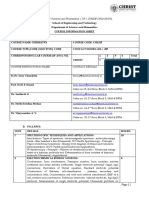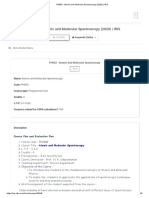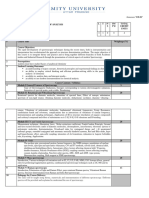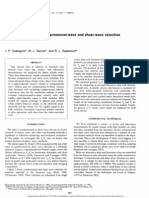MSC Syllabus
MSC Syllabus
Uploaded by
Sanjeeb SutradharCopyright:
Available Formats
MSC Syllabus
MSC Syllabus
Uploaded by
Sanjeeb SutradharOriginal Title
Copyright
Available Formats
Share this document
Did you find this document useful?
Is this content inappropriate?
Copyright:
Available Formats
MSC Syllabus
MSC Syllabus
Uploaded by
Sanjeeb SutradharCopyright:
Available Formats
M.
Sc (Chemistry), Choice Based Credit System, Batch 2018 and onwards
I.K. GUJRAL PUNJAB TECHNICAL UNIVERSITY
DEPARTMENT OF CHEMICAL SCIENCES
Course Name M.Sc. Chemistry
Subject Code: CHL414-18
Subject Title: SPECTROSCOPY-II
Contact Hours: L:4 T:0 P:0 Credits:4
Examination 3
Duration (hours)
Objective(s): To provide knowledge of advanced spectroscopic techniques for
identification and elucidation of structures of molecules
Details of the Course
Unit Contents Contact
Hours
I Microwave spectroscopy: Rigid and non-rigid rotator, Intensities 12
of spectral lines, isotopic substitution effects, polyatomic linear
and symmetric top molecules, Stark effect
Vibrational Spectroscopy: Types of vibrations, overtones,
combination and difference bands, Fermi resonance, group vibrations,
Harmonic and anharmonic oscillators, absorptions of radiation by
molecular vibrations, selection rules, force constant, frequency of
vibrational transitions of HCl, vibrations in a polyatomic molecule,
3N-6 and 3N-5 rules, Applications
II Raman Spectroscopy: Introduction, vibrational-rotational Raman 10
Spectra, selection rules, mutual exclusion principle, anisotropic
polarizabilty, Stokes, anti-Stokes lines, vibrational Raman spectra
of CO2 and H2O, polarised and depolarised Raman Lines.
Mössbauer Spectroscopy: Basic principles, Spectral parameters and
display, simple spin states (I 1/2, 3/2), higher spin states (I > 3/2),
magnetic splitting, quadruple splitting, additive model application to
57
Fe, 119Sn
III Nuclear Quadruple Resonance Spectroscopy: Introduction, 11
experimental considerations, fundamentals of NOR spectroscopy,
origin of EFG, measurement of energy differences between two
nuclear spin states, the asymmetry parameter, effects of the
magnetic field, interpretation of the spectra, application of NQR
spectroscopy
Photoelectron Spectroscopy-I: Introduction, photoelectron
spectroscopy, chemical shift, X-ray photoelectron spectroscopy,
molecular orbital diagrams of nitrogen and oxygen and their
XPS spectra-ESCA.
IV Photoelectron Spectroscopy-II: 12
Ultraviolet photoelectron spectroscopy (UPS), PES spectrum of
nitrogen sample, vibrational structure in the N2 UPS spectrum,
chemical shifts in XPS, exchange splitting and shake up process.
Electron Paramagnetic Resonance Spectroscopy: Principle,
Spectral display, hyperfine splitting in isotropic systems involving
more than one nucleus, Factors affecting magnitude of g values,
I.K. Gujral Punjab Technical University, Kapurthala Page 38 of 77
M.Sc (Chemistry), Choice Based Credit System, Batch 2018 and onwards
zero field splitting and Krammer’s degeneracy, Spectrum of benzene
radical anion, methyl radical, CH2OH, cyclopentedienyl,
cycloheptatrienyl radical, pyrazine anion, pyrazine anion, Spectra
of triplet states.
Reference Books
S.No. Author(s) Title of the Book Publisher/Year
1 R.S. Drago Physical Methods in inorganic Affiliated East-West
Chemistry Press (Section 1& 2)
2nd Edition,
Reinhold New York
(1968)
2 C. N. Banwell Fundamentals of Molecular McGraw-Hill, 1966
Spectroscopy
3 R. V. Parish NMR, NQR, EPR & Ellis Horwood,
Mossbauer spectroscopy in London, 1990
Inorganic Chemistry
4 G. M. Barrow Introduction to Molecular McGraw-Hill
Spectroscopy
5 E. A. Ebsworth, S.Craddock Structural methods in Blackwell Scientific
and D.W. H. Rankin Inorganic Chemistry Publications (1991)
6 C.N.R. Rao and J.R. Ferraro Spectroscopy in Organic Vol. I, Academic
Chemistry Press, 1971
Course Outcomes and Mapping
At the end of the course, the student will be able to
CO1. Learn the fundamental and advanced concepts of Microwave, Infrared-
Vibration-rotation Raman and infra-red Spectroscopy and their applications for
chemical analysis
CO2. Understand Electronic spectroscopy of different elements and simple
molecules.
CO3. Study the concepts and principles of Mössbauer Spectroscopy and its
application.
CO4. Apply Nuclear Quadruple Resonance and Electron Spin Resonance
Spectroscopy for organic compounds analysis.
CO5. Solve structural problems based on these techniques.
PSO1 PSO2 PSO3 PSO4 PSO5 PSO6 PSO7
CO1 3 3 3 1 3 3 3
CO2 3 4 3 1 3 3 3
CO3 3 4 2 - 3 4 3
CO4 3 3 2 - 3 4 4
CO5 3 5 2 2 4 4 3
I.K. GUJRAL PUNJAB TECHNICAL UNIVERSITY
I.K. Gujral Punjab Technical University, Kapurthala Page 39 of 77
You might also like
- Fundamentals of Molecular Spectroscopy: Fourth EditionNo ratings yetFundamentals of Molecular Spectroscopy: Fourth Edition10 pages
- Fb 54522179 d 1977635979632 Dc a 06534598383262No ratings yetFb 54522179 d 1977635979632 Dc a 065345983832629 pages
- Full download Annual Reports on NMR Spectroscopy Volume 81 1st Edition Graham A. Webb (Eds.) pdf docx100% (2)Full download Annual Reports on NMR Spectroscopy Volume 81 1st Edition Graham A. Webb (Eds.) pdf docx61 pages
- PDF Annual Reports on NMR Spectroscopy Volume 81 1st Edition Graham A. Webb (Eds.) download100% (4)PDF Annual Reports on NMR Spectroscopy Volume 81 1st Edition Graham A. Webb (Eds.) download60 pages
- Annual Reports on NMR Spectroscopy Volume 81 1st Edition Graham A. Webb (Eds.) All Chapters Instant DownloadNo ratings yetAnnual Reports on NMR Spectroscopy Volume 81 1st Edition Graham A. Webb (Eds.) All Chapters Instant Download51 pages
- Electronic Spectra of Transition Metal ComplexesNo ratings yetElectronic Spectra of Transition Metal Complexes10 pages
- Master of Science (Chemistry-Physical) Sem-3-4No ratings yetMaster of Science (Chemistry-Physical) Sem-3-415 pages
- B.SC (PCM) V & VI Semester Syllabus 2015-18No ratings yetB.SC (PCM) V & VI Semester Syllabus 2015-1827 pages
- Analytical Techniques in GPAT- Mastering SpectroscopyNo ratings yetAnalytical Techniques in GPAT- Mastering Spectroscopy7 pages
- Contemporary Topics in Analytical and Clinical Chemistry volume 3 1st Edition David Hercules download pdf100% (4)Contemporary Topics in Analytical and Clinical Chemistry volume 3 1st Edition David Hercules download pdf65 pages
- RCK-PHY-E313-Atomic and Molecular Spectroscopy Syllabus-StudentsNo ratings yetRCK-PHY-E313-Atomic and Molecular Spectroscopy Syllabus-Students2 pages
- Nuclear Magnetic Resonance Spectroscopy and Imaging in Animal ResearchNo ratings yetNuclear Magnetic Resonance Spectroscopy and Imaging in Animal Research20 pages
- Ebooks File Contemporary Topics in Analytical and Clinical Chemistry Volume 3 1st Edition David Hercules All Chapters100% (4)Ebooks File Contemporary Topics in Analytical and Clinical Chemistry Volume 3 1st Edition David Hercules All Chapters62 pages
- PDF 42 B Laporan Praktikum NMR - CompressNo ratings yetPDF 42 B Laporan Praktikum NMR - Compress15 pages
- BSC Syllabus at MWU 2012 - 5th SemesterNo ratings yetBSC Syllabus at MWU 2012 - 5th Semester26 pages
- Structural Elucidation of Small Organic Molecules by 1d 2d and Multi Dimensional Solution NMR Spectroscopy 2155 9872.S11 001No ratings yetStructural Elucidation of Small Organic Molecules by 1d 2d and Multi Dimensional Solution NMR Spectroscopy 2155 9872.S11 0018 pages
- PH802 - Atomic and Molecular Spectroscopy (2020) - IRISNo ratings yetPH802 - Atomic and Molecular Spectroscopy (2020) - IRIS2 pages
- Course Information: Code Course Level SLT Credit Unit Contact Hour Course Status PrerequisiteNo ratings yetCourse Information: Code Course Level SLT Credit Unit Contact Hour Course Status Prerequisite2 pages
- Spectroscopic Methods in Organic Chemistry-INo ratings yetSpectroscopic Methods in Organic Chemistry-I2 pages
- Adhesives, Auto & Cycle Parts, Rubber Beltings, Login Forgot Password Join FreeNo ratings yetAdhesives, Auto & Cycle Parts, Rubber Beltings, Login Forgot Password Join Free4 pages
- ELCO-Coupling: Innovative Power TransmissionNo ratings yetELCO-Coupling: Innovative Power Transmission24 pages
- Design of Machine Elements Project: Topic: Two-Stage Reduction GearboxNo ratings yetDesign of Machine Elements Project: Topic: Two-Stage Reduction Gearbox9 pages
- Guided Revision: Section-I Single Correct Answer Type 9 Q. (3 M (-1) )No ratings yetGuided Revision: Section-I Single Correct Answer Type 9 Q. (3 M (-1) )25 pages
- 38 1 011-FundamentalsOfBeamBracing-YuraNo ratings yet38 1 011-FundamentalsOfBeamBracing-Yura16 pages
- Piller Mechanical Vapor Recompression BlowersNo ratings yetPiller Mechanical Vapor Recompression Blowers8 pages
- IMPGas RE-INSPECT - Intervals-Draft PDFNo ratings yetIMPGas RE-INSPECT - Intervals-Draft PDF61 pages
- C_Sol_Ch-12_Chemical Kinetics and Nuclear ChemistryNo ratings yetC_Sol_Ch-12_Chemical Kinetics and Nuclear Chemistry14 pages
- Example: Calculating Frequencies Mode Shapes For A MDOF StructureNo ratings yetExample: Calculating Frequencies Mode Shapes For A MDOF Structure3 pages
- zhang-et-al-2023-synergetic-oxidation-of-the-hydroxyl-radical-and-superoxide-anion-lowers-the-benzoquinone-intermediateNo ratings yetzhang-et-al-2023-synergetic-oxidation-of-the-hydroxyl-radical-and-superoxide-anion-lowers-the-benzoquinone-intermediate10 pages
- A Review of Automobile Waste Heat Recovery System: Prof. Murtaza Dholkawala, Mr. Ahire Durgesh VijayNo ratings yetA Review of Automobile Waste Heat Recovery System: Prof. Murtaza Dholkawala, Mr. Ahire Durgesh Vijay7 pages
- HRAC 112 Lecture Week 1 Matter, Molecules, WorkNo ratings yetHRAC 112 Lecture Week 1 Matter, Molecules, Work22 pages
- [78] 14 - 2023 - Exp - Heat transfer performance of DWCNTs nanofluids in shell and tube heat exchanger with segmental baffleNo ratings yet[78] 14 - 2023 - Exp - Heat transfer performance of DWCNTs nanofluids in shell and tube heat exchanger with segmental baffle7 pages





